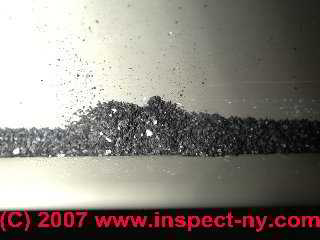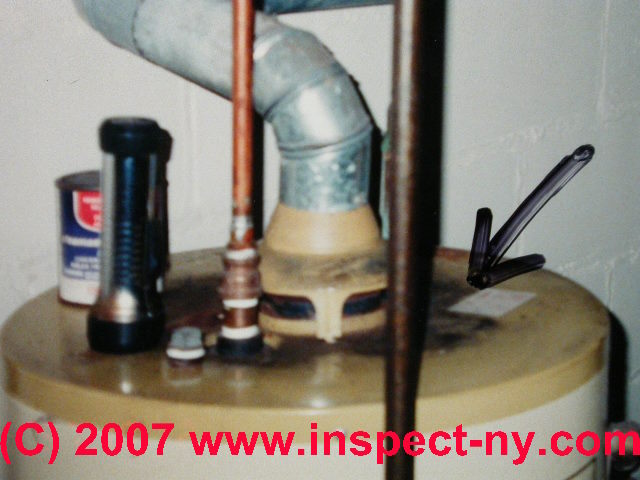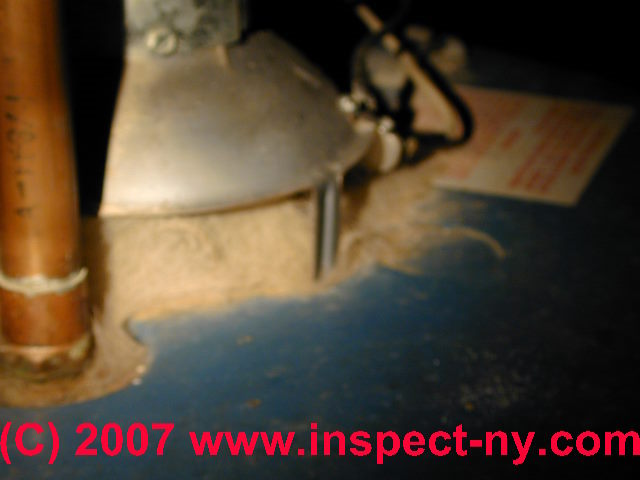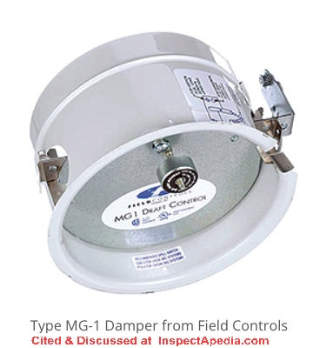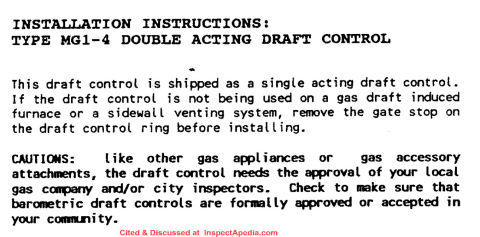 Guide to Draft Hoods & Draft Regulators
Guide to Draft Hoods & Draft Regulators
on Gas Fired Heating Equipment
- POST a QUESTION or COMMENT about draft hoods on gas fired boilers & furnaces: inspection, troubleshooting, repairs, hazards
Draft regulation for gas fired heating equipment: draft hoods.
Here we explain the purpose and function of draft hoods or vents on gas fired boilers, furnaces, water heaters or other gas fired heating equipment.
We give the purpose of these key venting devices on gas fired appliances.
We list and give photo-examples of common operating and safety defects found at draft hoods and draft regulators on gas fired heating equipment.
InspectAPedia tolerates no conflicts of interest. We have no relationship with advertisers, products, or services discussed at this website.
- Daniel Friedman, Publisher/Editor/Author - See WHO ARE WE?
Guide to Draft Hoods & Regulators on Gas Fired Furnaces, Boilers, Water Heaters - Purpose, Inspection, Repair
This article describes draft regulating devices on gas fired heating equipment.
The draft hood or draft regulating device we are discussing here is normally used only on gas-fired heating equipment, not on oil-fired equipment.
But you won't always find a draft hood: some gas fired equipment uses a separate draft regulator or barometric damper that we illustrate later on this page.
Similar barometric draft regulators are also used on oil fired equipment and more examples of those are at
DRAFT REGULATOR, DAMPER, BOOSTER.
Article Contents
- WHAT is a DRAFT HOOD on gas fired heating equipment?
- DRAFT HOOD DEFECTS and signs of trouble
- RUST at the DRAFT HOOD - significance
- SOOT at the DRAFT HOOD
- STAINS or DEBRIS at the draft hood
- FLUE GAS SPILLAGE at the draft hood
- BLOCKAGE at the draft hood or flue
- MANUALS for draft hoods & vents on gas equipment
What is a Gas Appliance, Furnace, Water Heater, or Boiler Draft Hood
This photo of a York gas fired furnace displays a conventional draft hood opening - the large horizontal opening space shown in the middle of the furnace.
The purpose of this opening is to permit additional air to flow into the flue vent connector (stack pipe) and chimney when the gas burner is operating. This additional air flow avoids excessive draft at the gas burner.
Too much draft at the gas burner could result in improper gas combustion.
The gas burner will be below this opening and behind the cover with the louvered openings. The louvers provide combustion air to the gas burner.
Defects & Trouble Signs in Gas Appliance Draft Hoods
 Improper gas appliance draft hood location or size is dangerous
Improper gas appliance draft hood location or size is dangerous
Dome type gas appliance draft hood clearances:
Dome type draft hoods are commonly installed on gas fired heating boilers.
For dome type draft hoods such as the funnel-shaped device shown at the center of this photo (air enters at the under-side of the dome) the manufacturer of the boiler specifies the required distance from the bottom edge of the hood to the top surface of the boiler.
Usually this clearance required for gas fired appliance draft hoods is given in inches, embossed right into the lower edge of the draft hood itself.
Look for the draft hood clearance specification and measure what is actually installed.
If the draft hood is installed too close to the boiler top, or too high, too far above the boiler top, it will not work properly and the system may be unsafe.
Modification or removal of a draft hood can be very dangerous,
and also the presence of rust or debris on top of the boiler below the draft hood may indicate a dangerous condition such as a blocked chimney - risking dangerous combustion gas or carbon monoxide spilling in the building.
We describe a case history where this occurred
at DANGEROUS CHIMNEY CASE STUDY.
Rust or damage at the gas heater or water heater draft hood and what it means
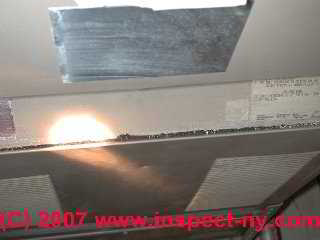
These photos show an unusual accumulation of debris at a gas fired furnace draft hood opening.
Rust at this location at a furnace draft hood could indicate an unsafe condition.
If the chimney draft is inadequate or if the chimney is blocked, or if the heater has been damaged by flooding or other wet conditions, you may observe rust and debris on and around the gas operated furnace, boiler, or water heater draft hood. Further inspection by an expert is needed.
Soot at the Draft Hood or Elsewhere on Gas Fired Heating Equipment
Watch out: the presence of fragments of soot or soot staining on gas fired heating equipment may indicate a very dangerous condition in which improper combustion, probably inadequate combustion air or a blocked chimey or flue, can cause the production of fatal carbon monoxide gas in the building.
The safest step if you see soot formation at gas fired heating equipment is to turn it off immediately.
In all events be sure that you have working carbon monoxide detectors properly installed and located in the building as well, of course, as smoke detectors and alarms.
Stains or Debris at the Gas Hood
Watch out: The black stains around the draft hood on this water heater were an indication of something seriously wrong with the installation.
Tracing the flue vent connector from the draft hood atop the water heater (shown in this photo) to its connection at a chimney (not shown) we found that while the water heater was a gas fired appliance it was sharing a flue with an oil fired heating boiler whose chimney was blocked.
Backpressure
at the chimney was sending the oil burner's exhaust back down the gas-fired water heater's flue and into
the building.
Unsafe Flue gas spillage at a water heater draft hood
Our client is pointing to the draft hood on the gas fired water heater in the home she was buying.
We could see two things: first, foam insulation on the hot water pipe was melting and second, we suspected that there was excessive flue gas spillage from this appliance.
Watch out: This is an unsafe condition
that needs investigation and repair.
Dangerous Blockages at a water heater draft hood
Watch out: Look for signs of debris or any other material that blocks clear flow of air into the gas heater's draft hood. Blockage can cause improper venting, improper combustion, and even an increase in heating costs.
This photo of a draft hood on the gas fired water heater in the home lets us see two concerns:
First, the gas fired water heater's draft hood was partly blocked with hair - so the water heater may not be burning its fuel nor venting its combustion gases safely.
Second, the previous owner of the home must have kept a very hairy and shed-prone dog in the basement where it's hair was so thick in the air that the draft hood was blocked.
If this home were going to be occupied by someone with dog allergies, extensive cleaning would also be in order.
More photos and descriptions of gas water heater defects including draft hood issues can be seen
Gas Fired Equipment Draft Regulator & Barometric Damper Control Manuals
- Field Controls CONTRACTOR REFERENCE GUIDE [PDF] (2018) - Field Controls, 2630 Airport Road
Kinston, NC 28504 USA, Tel: 252.522.3031 original source: fieldcontrols.com/wp-content/uploads/2019/05/4338_ContractorReferenceGuide_2018.pdf
- Field Controls, MG1-4 DOUBLE ACTING DRAFT CONTROL INSTALLATION INSTRUCTIONS [PDF] source: Field Controls, fieldcontrols.com/wp-content/uploads/2019/05/46200000.pdf
- National Fuel Gas Code (Z223.1) $16.00 and National Fuel Gas Code Handbook (Z223.2) $47.00 American Gas Association (A.G.A.), 1515 Wilson Boulevard, Arlington, VA 22209 also available from National Fire Protection Association, Batterymarch Park, Quincy, MA 02269. Fundamentals of Gas Appliance Venting and Ventilation, 1985, American Gas Association Laboratories, Engineering Services Department. American Gas Association, 1515 Wilson Boulevard, Arlington, VA 22209. Catalog #XHO585. Reprinted 1989.
...
Reader Comments, Questions & Answers About The Article Above
Below you will find questions and answers previously posted on this page at its page bottom reader comment box.
Reader Q&A - also see RECOMMENDED ARTICLES & FAQs
On 2023-11-01 by InspectApedia Publisher (mod)
@Donald H Roman,
Thank you that's a very interesting question for which I do not have an authoritative answer.
First, for other readers let's explain the difference between single-acting and double-acting barometric dampers.
Definition of single-acting barometric damper:
this oil or gas burner draft regulating device opens or closes to allow additional air from the building to enter the chimney flue in order to regulate thhe chimney draft, keeping it at the proper level. If there is a sudden downdraft or back-flow in the chimney, the single acting damper will simply close to minimize escape of flue gases into the building interior.
Single acting barometric dampers are most-often used on oil fired heating equipment.
Definition of double-acting barometric dampers:
like the single acting damper, a double acting barometric damper is intended to regulate draft at heating equipment. But unlike a single-acting damper, the double-acting barometric damper "flapper" door can swing not only to let room air into the chimney or flue (preventing too much draft) it can also swing to allow excess pressure inside the flue to vent back out at the damper opening, responding, for example to sudden downdrafts or backdrafts.
Watch out: some draft controls like the Field MG1 can work as a double-acting barometric damper OR as a single-acting damper and are shipped set-up as a single-acting damper control:
Choosing the Right or Best Barometric Damper when Converting from Oil to Gas Burner
Now let's discuss choosing the right or best damper control when changing from an oil burner to gas burner on your heating boiler.
You may know (or not) that the exhaust venting requirements and parameters of oil fired equipment are quite different from gas fired equipment. The draft and operating temperatures, for example are very different.
Watch out: The immediate and very important step you can take for your safety is to be sure that there are working carbon monoxide and smoke detectors installed, properly located, and tested regularly. You want to assure that even if draft is improper you can be warned of dangerous or even fatal carbon monoxide spillage into your apartment.
It would be very helpful if you could post a photo of the damper that's installed on your heater.
Indeed double-acting barometric dampers are often installed on conversion burners such as your setup.
If at your particular building there has been a history of problematic chimney downdrafts AND if an expert has already inspected your chimney for safety and correct installation, including the chimney cap (that usually is perfectly adequate to prevent downdraft problems), THEN indeed you might need a double acting barometric damper.
But the specific requirements of your boiler and your new gas burner are also key.
I think that the final authoritative answer to the question of whether a double action barometric damper is *required* for your heating boiler should come from either its installation & operation manual or directly from the manufacturer of the boiler and of the burner.
Field Controls, a manufacturer of draft control equipment, does offer some specific guidance that you should discuss with your installer, as I quote below:
Gas-Fired Appliances
Gas-fired furnaces and boilers generally require a double-acting draft control. Like a single-acting control, it opens inwardly to maintain a uniform draft. But, unlike a single-acting control, it is also free to open outwardly to spill the products of combustion, in case of blocked flues or downdrafts.
National codes often mandate the use of a draft control.
Usage is generally limited to furnaces or boilers designed for use with power burners and incinerators.
Draft controls are generally used when oil-fired units are converted to gas. - source: Field Controls CONTRACTOR REFERENCE GUIDE [PDF] (2018) - original source: www.fieldcontrols.com/wp-content/uploads/2019/05/4338_ContractorReferenceGuide_2018.pdf copy also available here at
inspectapedia.com/heat/Contractor-Reference-Guide-Field-Ctls.pdf
And here's what Field Controls says about their MG1 double acting barometric damper:
A double-acting control for gas-fired furnaces and boilers is widely used for conversion burner installations, gas draft-induced appliance operation with mechanical draft inducers, or sidewall power venters.
It is also recommended for use on gas atmospheric appliances where a draft hood cannot be installed, and can improve combustion stability and draft on many gas atmospheric installations with venting problems.
The MG-1 provides precise, accurate control of drafts at levels higher than permitted by a standard draft diverter, which is a frequent requirement with gas.
Because it is double-acting, it opens out to relieve positive vent system pressures as low as .01″. Draft adjustments using weights are simple and accurate from .01″ to .1″. - source: Field Controls, original source: fieldcontrols.com/mg1-csa-ul-and-cul-double-acting-for-gas/#1664278199219-9aed577b-2efc
At the start of our reply we show an example the Field MG1 double acting draft control, below, for which Field provides these
MG1-4 DOUBLE ACTING DRAFT CONTROL INSTALLATION INSTRUCTIONS [PDF] source: Field Controls, fieldcontrols.com/wp-content/uploads/2019/05/46200000.pdf
copy here also at
https://inspectapedia.com/heat/MG1-Draft-Regulator-Instructions-FieldControls.pdf
On 2023-10-31 by Donald H Roman - Proper draft regulator after converting from Beckett oil burner to Carlin Gas Burner on SGO6 Boiler
I have recently changed the Beckit oil burner that was on my SGO6 boiler to Carlin GAS BURNER. I now notice that the plumber used a SINGLE ACTING BAROMATRIC DAMPER and not a double acting damper.
The plumber now added a SPILL SWITCH to the single acting damper and told me that he has been doing this type of installation form over 25yrs. and never had a single issue. I too now, so far, has no problem at all, and the boiler seems to be working fine.
I AM NOW HOWEVER WORRIED THAT SOMETHING MAY BE WRONG HERE, AS I AM NOW UNDERSTANDING THAT GAS BURNERS SHOULD USE DOUBLE ACTING DAMPERS. What should I do?
P.S. i live in the basement next door to this boiler in NYC.
On 2016-12-23 y danjoefriedman (mod) - gas company finds unsafe gas heater
Mike:
In my opinion your inspector was being extra cautions to avoid seeing you dead from CO poisoning.
In particular, if there is spillage OUT at the draft hood (or anywhere else) when the heater is running (after it has had a few minutes to warm up itself and also the chimney) then the system is dangerous and should be shut down pending repair.
It should be possible to install a flue gas spillage detector (usually a pair of them) on the draft hood. That device will automagically turn off the burner if there is spillage - thus it's a great safety improvement that you'll find on newer gas furnaces and water heaters. Search InspectApedia for FLUE GAS SPILL DETECTOR for details.
Once you've established that draft is actually inadequate and that the burner's adjustment and combustion air are absolutely correct, then you'll want an experienced certified chimney sweep to inspect the chimney for damage or unsafe conditions.
Recently working with a service tech on a Minnesota home heated by a gas boiler we found that there was slight flue gas spillage at the draft hood.
It took no more than a dope like me looking behind the boiler to see that there was a chimney flue cleanout door for the boiler's flue that was both left ajar and also rusted -through with big holes in it.
We cleaned the crud from the chimney flue bottom, repaired the door, and closed it. Magically the draft improved significantly.
In less common cases it could be necessary to add a power vent or draft inducer fan to assure safe draft. But I would never apply that solution before checking the chimney thoroughly for blockages, holes, leaks, excessive size, excessive height, missing chimney cap or other problems.
On 2016-12-23 by Mike C.
We have an old natural gas top vent wall furnace model Williams B35SD. Gas company inspector said there is no cool air going into the draft hood and this indicated spillage problem.
He suggested we inspect the vent ducting. We have inspected and cleaned the ducting. There is no improvement. What could be the problem and any suggestion on what we should do to fix the spillage problem. Thanks.
Question: my barometric damper has a wire running from it to my ignitor.
(Mar 17, 2015) nate said:
my barometric damper has a wire running from it to my ignitor. It is tied into where my thermostat plugs in to my ignitor also. Why would they do that?
Reply:
(Mar 19, 2015) (mod) said:
Nate I'm not sure what you're describing. If your damper is a power-operated unit then indeed it would be connected to your heating system so that the heater would not fire up if the damper were not open.
I suspect you mean that there is a spill switch - a safety device - installed. If there is flue gas spillage at the draft hood the spill switch turns off the heater.
Question: Plumber says the draft hood doesn't have to be attached securely
(May 12, 2015) Michael Chambers said:
I've got the plumber that installed a water heater telling the seller that the draft hood does not have to be securely attached to the top of a water heater. I told the buyer's agent that the plumber just doesn't want to have to come back and correct his error for free.
We don't do code, but it stands to reason that if the vent pipe has to be attached to the draft hood by at least three screws, then the draft hood in turn has to be securely attached to the top of the water heater.
If I can lift the draft hood up and move it away from the vent coming out of the water heater, then it's just that easy for CO to be released into the house. So who's right, me or the plumber?
I need some backup here. Thanks!
Reply:
Michael
The draft hood needs to be secured somehow; it may be secured by how it's connected to the flue vent connector, or depending on the heater model it may have feet that are screwed to the heater top
. It depends. Use our CONTACT link to send me some photos and I'll comment further. Also give me the brand and model number of the heater.
Watch out: If a draft hood can fall, blow, or be bumped out of place the heating appliance would be unsafe.
...
Continue reading at DRAFT MEASUREMENT, CHIMNEYS & FLUES or select a topic from the closely-related articles below, or see the complete ARTICLE INDEX.
Or see these
Recommended Articles
- AUTOMATIC VENT DAMPERS
- CHIMNEY DRAFT & PERFORMANCE
- COMBUSTION AIR REQUIREMENTS
- DRAFT REGULATOR, DAMPER, BOOSTER - home
- DAMPERS & DRAFT REGULATOR TYPES
- DRAFT REGULATORS / HOODS GAS HEATERS
- DRAFT INDUCER FANS
- DRAFT MEASUREMENT, CHIMNEYS & FLUES
- DRAFT REGULATOR SOOT INSPECTION
- GAS FIRED WATER HEATERS
- MANUALS for HEATING & A/C SYSTEM CONTROLS
- MANUALS & PARTS GUIDES - HVAC
Suggested citation for this web page
DRAFT REGULATORS / HOODS GAS HEATERS at InspectApedia.com - online encyclopedia of building & environmental inspection, testing, diagnosis, repair, & problem prevention advice.
Or see this
INDEX to RELATED ARTICLES: ARTICLE INDEX to HEATING SYSTEMS
Or use the SEARCH BOX found below to Ask a Question or Search InspectApedia
Ask a Question or Search InspectApedia
Try the search box just below, or if you prefer, post a question or comment in the Comments box below and we will respond promptly.
Search the InspectApedia website
Note: appearance of your Comment below may be delayed: if your comment contains an image, photograph, web link, or text that looks to the software as if it might be a web link, your posting will appear after it has been approved by a moderator. Apologies for the delay.
Only one image can be added per comment but you can post as many comments, and therefore images, as you like.
You will not receive a notification when a response to your question has been posted.
Please bookmark this page to make it easy for you to check back for our response.
IF above you see "Comment Form is loading comments..." then COMMENT BOX - countable.ca / bawkbox.com IS NOT WORKING.
In any case you are welcome to send an email directly to us at InspectApedia.com at editor@inspectApedia.com
We'll reply to you directly. Please help us help you by noting, in your email, the URL of the InspectApedia page where you wanted to comment.
Citations & References
In addition to any citations in the article above, a full list is available on request.
- Domestic and Commercial Oil Burners, Charles H. Burkhardt, McGraw Hill Book Company, New York 3rd Ed 1969.
- Boilers, Boiler Conversions, James E. Brumbaugh, ISBN 0-672-23389-4 (v. 1) Volume II, Oil, Gas, and Coal Burners, Controls, Ducts, Piping, Valves, James E. Brumbaugh, ISBN 0-672-23390-7 (v. 2) Volume III, Radiant Heating, Water Heaters, Ventilation, Air Conditioning, Heat Pumps, Air Cleaners, James E. Brumbaugh, ISBN 0-672-23383-5 (v. 3) or ISBN 0-672-23380-0 (set) Special Sales Director, Macmillan Publishing Co., 866 Third Ave., New York, NY 10022. Macmillan Publishing Co., NY
- Installation Guide for Residential Hydronic Heating Systems
- Installation Guide #200, The Hydronics Institute, 35 Russo Place, Berkeley Heights, NJ 07922
- In addition to citations & references found in this article, see the research citations given at the end of the related articles found at our suggested
CONTINUE READING or RECOMMENDED ARTICLES.
- Carson, Dunlop & Associates Ltd., 120 Carlton Street Suite 407, Toronto ON M5A 4K2. Tel: (416) 964-9415 1-800-268-7070 Email: info@carsondunlop.com. Alan Carson is a past president of ASHI, the American Society of Home Inspectors.
Thanks to Alan Carson and Bob Dunlop, for permission for InspectAPedia to use text excerpts from The HOME REFERENCE BOOK - the Encyclopedia of Homes and to use illustrations from The ILLUSTRATED HOME .
Carson Dunlop Associates provides extensive home inspection education and report writing material. In gratitude we provide links to tsome Carson Dunlop Associates products and services.



